PREVIOUS:
THE RED SCARE BEGINS
Control and jurisdiction over Operation Overcast was shifted to the Joint Chiefs of Staff, who officially commissioned the project on July 20, 1945. To handle the operation, the Joint Intelligence Objectives Agency [JIOA] was eventually created as a subsidiary of the Joint Intelligence Committee [JIC], which was a subsidiary of the Joint Chiefs of Staff.
Any further description of their structures and hierarchy becomes incredibly monotonous and dry so we will skip ahead to their agenda and reports.
The JIC began focusing on Russia and their “emerging threat.” They presented 16 major intelligence reports and 27 policy papers focused on the Russians to the Joint Chiefs over the summer of 1945. The reports alleged that Russia was “ideologically hostile to the West and would continue to seek global domination.” The JIC estimated that the Soviets would be back at full military strength by 1952, at which point they would unleash “total war” upon the United States.
By October, they were estimating that 8 of every 10 leading German rocket and missile scientists had “gone missing” from Germany and were “most likely” working in the USSR. Two German physics laboratories had been transported and reassembled piece by piece in Russia – and along with them came the scientists who had worked there.
The JIOA assumed control of Overcast less than a month after the atomic bombs were dropped on Japan. The military intelligence community was focused on supremacy over Russia at any cost; “the fact that the scientists happened to be Nazis was incidental – a troublesome detail.” Leadership was comprised of the army’s director of intelligence, the chief of naval intelligence, the assistant chief of air force intelligence, and a representative from the State Department.
Due to the JIC reports of the imminent threat of the Soviets, one of the JIOA’s first tasks was to change the policies regarding qualifications for Nazis entering the US so that they could acquire more scientists in a short period of time. The three military leaders were in favor of this idea; the State Department Representative, Samuel Klaus, was firmly opposed to it. Klaus described the German candidates as “not brilliant scientists who had been unwittingly caught in a maelstrom of evil but rather they were amoral opportunists of mediocre talent.”
WAR PROFITS ARE NOW THE ABILITY TO PROFITEER
President Truman tasked the Department of Commerce with a program that was meant to “excite the nation about a unique form of reparations.” Germany was unable to provide financial reparations, but their science and technology could be plundered.
Thanks to Reich scientists, the public was told, beverage manufacturers could not sterilize fruit juice without heat. Women could enjoy run-proof hosiery. Butter could be churned at the rate of 1,500 pounds per hour. These lists seemed not to end. Yeast could be produced in unlimited quantities, and wool could be pulled from sheepskins without injuring the animal’s hide – all because of brilliant German scientists. Hitler’s wizards had reduced suitcase-sized electrical components to the size of a pinkie finger and pioneered electromagnetic tape.
Secretary of Commerce [and former Vice President] Henry Wallace was a leading voice in 1944 when President Roosevelt promised to bring 60 million jobs to the American people. He believed that “German science was a jumping-off point” to achieving these goals. Wallace had two lists: one for civilian technology and another for anything with “military potential.” The second list had over 1,800 items.
Wallace’s executive secretary and representative on the JIOA was John C. Green. Mr. Green understood and embraced the concept of war profiteering.
Regarding the classified list, Green got an idea. Peace and prosperity were, in principle, sound ideas. But there was big business in war. Green wanted to make the classified list available to certain groups in industry. “Specialized knowledge [should not be] locked up in the minds of German scientists and technicians,” Green said. It needed to be shared. To help foster this sharing, in the fall of 1945, John C. Green traveled to Wright Field, in Dayton Ohio, to meet with Colonel Donald Putt.
SPELL MY NAME RIGHT ON THE GRIEVANCE
The first group of Germans arrived to Wright Field in the fall of 1945. There were six of them, housing in a place called The Hilltop, hidden away from the rest of the base down a single lane dirt road. That dirt road also led to a trash dump, which was the first item on a “German list of grievances” to share with the Americans when “the time was right.”
In reality they had it rather good at The Hilltop. They were paid a salary of $12,480 annually plus a $6.00 per diem daily. According to the Inflation Calculator, that would amount to $179,643 annually with $86 per diem daily. A “clerical oversight” also meant they avoided paying taxes for the first couple years as well. A husband-and-wife housekeeping team did their laundry, made their beds, and tended to any other domestic needs. They were allowed to work out at the local YMCA on weekends.
But the Germans were mad that they weren’t getting the same “respect” that they got in Germany; in other words they were upset that the average Americans they worked with weren’t nice enough to them. [Wow, I can’t imagine why?]
Colonel Putt “could not fathom why the specialists were looked upon with contempt.” He said, “all they wanted was an opportunity to work.” He wanted the Germans to translate their work to English and give presentations to various defense contractors. The War Department put a stop to this idea – at least for now – mandating that they “remain properly segregated from persons not directly concerned with their exploitation.”
The Germans told Colonel Putt and his commanding general, Major Hugh Knorr, that they “felt like caged animals.” The two US directors attempted to negotiate with the Pentagon in favor of the Germans, arguing that they needed better living conditions before they could produce better work. The Pentagon shut them down again, telling them to wait until after the Nuremberg Trials.
NAZI SHOW & TELL
The Army Air Forces hosted a “grand two-day-long fair” at Wright Field that was extended to five days because of the huge turnout it generated. Reports stated that over 500,000 from 26 different countries attended. Captured German & Japanese aircraft and rockets were on display. They didn’t mention that some of the enemies who helped design the weapons were living just up the hill from the fair.
John Green from the Commerce Department was in attendance and had an agenda. He found Colonel Putt and shared his ideas about using the German science and technology in the private sector. Putt had already sneakily gotten letters of interest from several American companies about employing Germans, including Dow Chemical Company, the AiResearch Manufacturing Company, and the Aircraft Industries Association.
POLITICAL LEAKS ARE ALWAYS A DISTRACTION
The War Department leaked Dr. Alexander’s report about the freezing experiments to the press. The Washington Post published an article titled “Army Uncovers Lurid Nazi ‘Science’ of Freezing Men” on November 4, 1945, in an attempt to garner public interest in the Nuremberg trials.
The hypocrisy was in full swing. Many of the physicians who participated in or were party to the crimes displayed in the trials were working for the US Army Air Forces Aero Medical Center in Germany, less than 150 miles from Nuremberg.
Dr. Hubertus Strughold, the [now former] Chief of Aeronautical Research for the Luftwaffe, began working there back in September alongside 58 others he was allowed to pick himself. Strughold was the individual in charge of the freezing experiments and the compression chamber experiments that killed human subjects. Much of the data he obtained was now being used for the Americans.

[Bonus fact: I don’t have a good place to put this without going into far too much of his background: Dr. Strughold traveled to the United States in 1928 to attend the University of Chicago after receiving the offer of a prestigious fellowship with the Rockefeller Foundation. Even at that time, he was importing dogs from Canada to use as test subjects for oxygen deprivation, as experimenting on dogs born in the US was illegal. He only stayed in the US for about year.]
With the Nuremberg trial under way, the international press had its attention focused on war crimes. German doctors were looked at with suspicion. Articles about Nazi doctors, including the November 1945 piece in the Washington Post about the “science” of freezing humans, put a spotlight on Germany medicine. Many doctors fled the country to South America through escape routes called ratlines. Others tried to blend in by offering their services in displaced persons camps. Some killed themselves.
NEW YEAR, NEW YOU. [STILL NAZIS]

By the end of January 1946 there were 160 Nazi scientists in America, 115 of whom were rocket specialists at Fort Bliss, Texas, being “supervised” by Wernher von Braun, the mastermind behind the V-2 Rockets used by the Nazis. The Germans shared their dining hall with a large group of Native Americans, which led von Braun to tell his mother that he “felt like he was living life inside an adventure novel.”
[Bonus fact: He went on to write his own novel, a science fiction book about space travel to Mars, along with a non-fiction, scientifically accurate book about traveling to Mars, both of which were named The Mars Project as far as I can tell. A few photographs of the original manuscript for the fictional book can be seen here on Imgur. The full book can be seen here in a Google Drive PDF. Note that the man who is the leader of the Mars government receives the title “Elon.” The technical guide can be viewed here in a Google Drive PDF uploaded by an anonymous Reddit user.]

They were performing V-2 rocket tests at the White Sands Proving Ground in New Mexico. About 12-15 of them were sent to White Sands at one time and lived in a barracks with employees from the General Electric Company and an army technical unit.
The first test took place in April 1946. It made it three miles into the air, but one of the fins fell off. Wernher von Braun saw the promise of the capabilities, however; he wrote a memo to Robert Oppenheimer [creator of the atomic bomb] proposing the idea of merging the V-2 missile with the atomic bomb. He was asked to turn it into a full blown proposal, which became “Use of Atomic Warheads in Projected Missiles.” In it, von Braun suggested building a rocket with the same principles as the V-2 capable of carrying a 2,000+ pound nuclear payload a distance of more than 1,000 miles.
Meanwhile, in von Braun’s personal life were two major changes:
The first was that he joined an Evangelical Christian church and became “born again,” something he rarely discussed in public. The second was that he decided to marry his first cousin, Maria von Quistorp, the daughter of his mother’s brother. Von Braun was nearly twice her age – she had just turned 18 that summer – and she lived in Germany.
Experiences in America varied greatly among the Germans.
Arthur Rudolph, the facilitator of the slave labor for the Mittelworks factory that constructed the V-2 rockets, said he was happy that the swimming pool and bowling alley on base were open exclusively for Germans on one day each week so he didn’t have to deal with the Americans.
Magnus von Braun, Wernher’s brother, was under FBI investigation for selling a platinum bar he had illegally smuggled into the US.
Some of them had also lied about how talented they were just to get the ride to America. For example, a man Karl Otto Fleischer claimed to be a high ranking member of the Wehrmacht, but had actually only been in charge of food services.
The earliest newspaper article I could find that specifically used the name “Operation Overcast” was from February 19, 1946 in the Knoxville News Sentinel.
MORE WHINING BACK IN OHIO
In the winter of 1946, the number of Germans at Wright Field had now expanded to 30. Colonel Putt “considered this sum to be offensively low.” He routinely sent memos to the War Department asking for more, but was turned down.
The Air Documents Research Center had recently been moved from London to Wright Field, which employed 500 men who were sorting, cataloging, and indexing 1,500 tons of Germany documents. More than 100,000 new technical words were added to the Air Material Command’s dictionary as a result.
The Germans were still upset with their “treatment” at Wright Field. Albert Patin, a Nazi businessmen working at Wright Field, presented the list of grievances to Colonel Putt. In summary:
It was not just the lack of challenging work, it was the whole package deal. The Hilltop was a dump. Payments were slow. The mail to Germany was even slower. Dayton had no civilized culture. The laboratory facilities at Wright Field were nothing compared to the grand laboratories of the Third Reich. In general, they were beginning to “distrust” their American hosts “based on promises broken by USA officers.”
Colonel Putt was desperate to get more scientists under his control – and fast. He decided to talk to Albert Patin about the list of grievances and asked him to help with devising a marketing strategy they could use to get more Germans to Wright Field.
Patin had overseen factories during the war that produced navigation aids, in-flight steering mechanisms, and automatic control devices. Those factories used human slave labor. The slaves were provided directly by Heinrich Himmler and the SS. Patin also had great rapport with Hitler and others in his inner circle. He took summer holidays with Hermann Göring’s family and winter trips with Albert Speer’s “procurement chief,” Dieter Stahl.
None of that stopped Putt from wanting to win his battle. He asked Patin to write a formal letter of grievances, with emphasis on “how the Germans had become depressed, even suicidal, without their families and without the promise of long-term work.” The letter was sent to Brigadier General John A. Samford at the Air Force Headquarters in DC.
Samford had already been keeping an eye on Patin. All incoming mail to the Germans was screened by army intelligence, and Patin had received “lucrative” offers from the French and the Russians to come work for them instead. Samford forwarded the complaint letter to the War Department along with his own commentary:
“Immediate action in this situation is imperative if we are to divert the services of valuable scientists from France and Russia to the United States.
This was fortuitous timing for Samford, Putt, and Patin. The Joint Intelligence Committee was working on major policy changes in how they would deal with the Russians. They believed that “using restraint” was no longer on the table, and that:
Unless the migration of important German scientists and technicians into the Soviet zone is stopped, we believe that the Soviet Union within a relatively short period of time may equal United States developments in the fields of atomic research and guided missiles and may be ahead of US developments in other fields of great military important, including infra-red, television, and jet propulsion.
They also stated that the Russians were very close to having their own atomic bomb due to the help of the Germans; this was untrue: there had been a British scientist named Karl Fuchs at Los Alamos who leaked the technical data for the bombs to Russia.
The JIC proposed immediate changes to the Nazi scientist program to curtail the Russian threat. One was to work to prevent any more Germans from being scooped up the Russians. Another was “that the US Army was to make sure that the German scientists and their families were given whatever it was they were asking for, including American visas.”
They also made a list of 1,000 more Germans that they would pre-approve for transport to America for weapons-related research.
Robert Patterson, who had now been promoted to US Secretary of War [from Undersecretary of War], had changed his tune about the program as well in the past year. He was initially opposed, but the thought of Russia leaping ahead of the US in technology worried him. He said that the War Department “should do everything possible to clear away any obstacles that may be raised in the State Department.”
Patterson spoke with Secretary of State James Byrnes and the two men agreed that “leaving German scientists unsupervised inside Germany, where they could be bought by the Russians, is too dangerous.”
This led to a new policy [SWNCC Paper No. 275/5] that allowed any German scientist of “national interest” to the US to be admitted. This also created a loophole: they didn’t necessarily have to be of Russian interest to get the invitation to the US.
The more difficult part would be getting approval for individuals who had exceptionally dirty records with the Nazis, especially members of the SS and SA or anyone who received awards from Nazi high command. The regulations still prevented bringing them into America.
The Army intelligence officers came up with a plan: they put a paperclip on the files of the “more troublesome Germans.” Those files were not immediately presented to the State Department; the persons marked with the paperclips would remain in military custody in America [for now].
This lead to the new name of the program: Operation Paperclip.
LOWER STANDARDS FOR HIGHER SCIENCE
The JIOA changed the language of the policy again under the premise of “America’s national interest.” The phrases “no known or alleged war criminals” and “no active Nazis” were changed to “no persons who might try and plan for resurgence of German military potential.”
This still did not allow for permanence and left the possibility that the State Department could kick them out at any time.
Another convenient report on the Soviets made its way to Washington around this time. The “Long Telegram” was sent to the Secretary of State by George Keenan, an American diplomat to Moscow. President Truman forwarded the memo to every US embassy around the globe. The determination was that, “in the long run there can be no permanent peaceful coexistence with the Soviet Union.” In addition:
Soviet leaders believe that a conflict is inevitable between the USSR and the capitalist states, and their duty is to prepare the Soviet Union for this conflict. Soviet leaders were on a path designed to lead to eventual world domination. The Russians were developing atomic weapons, guided missiles, a strategic air force, and biological and chemical weapons programs. The idea of peaceful coexistence of communist and capitalist nations is impossible. The only way to counter this threat is the “language of military power.” Not military force, but military threat.
Truman eventually gave in and signed off the entire program, including the additional 1,000 scientists and technicians requested by the JIOA and JIC. The Presidential approval also inspired the various departments to expedite the process of granting visas to the men and their families.
The JIC then wrote their assessment of the Soviet threat. That report said the Soviet Union “sought world domination” and would “begin by bringing other nations into Soviet control to isolate the capitalist world.” They predicted any war with the USSR to be “of apocalyptic proportions” and suggested that the US prepare for “total war.” To do so, the US would need to “maintain military supremacy in all areas of war fighting, including chemical warfare, biological warfare, atomic warfare, and any other kind of warfare the other side dreamed up.”
It is unknown if President Truman received a copy of this particular memo.
HIDE THE WORST ONES; USE THEM ANYWAY
Dr. Kurt Blome, one of the primary men responsible for testing viruses, plagues, and other diseases on concentration camp prisoners, was one of the scientists that the Americans had to keep hidden away a while longer in Germany. Explaining why the top biological weapons director for the Nazis was in the US would be more difficult to explain than lesser-known individuals. The US Army Military Intelligence Service Center at Darmstadt employed Blome as a “doctor” in the summer of 1946.
During the war, Blome had made significant progress with weaponizing plague pathogens, especially bubonic and pneumonic plague. His team had also studied the yellow fever in conjunction with the Japanese Unit 731.
The American “counterpart” to Dr. Blome was Dr. Theodor Rosebury, a bacteriologist for the US whose work was classified at the same level of secrecy as the atomic bomb. He worked on the bubonic plague, and with his colleagues, a total of 199 “germ bomb” projects, including “anthrax spore production, plant and animal diseases, and insect research.”
The justification was that if the Nazis had used biological weapons, the Americans would have retaliated with similar attacks.
Now the justification turned to the “Russian threat,” which led to the continuation of the biological weapons research. Biological bombs could be made by any number of countries regardless of their financial and atomic resources. This was included in something called the Merck Report.
The author of said report was George W. Merck, a chemist and owner of Merck & Co., a pharmaceutical manufacturer in New Jersey. His company made and sold vaccines, including the first smallpox vaccine in 1898 and penicillin G in 1942.
In other words: the man who was analyzing the biological threat was the same man who would potentially sell the vaccines and treatments to the government to combat the threat.
Unfortunately for Blome and the Americans who wanted to use his services, the Soviets showed up at the eleventh hour in Nuremberg with a surprise witness: Blome’s counterpart, Dr. Walter Schreiber, the one who was supposed to be developing the vaccines for the Germans against Blome’s weapons. Schreiber turned completely on the former Nazis at trial and gave enough evidence that Blome ended up on the defendant list instead of the Paperclip list.
[ALLEGEDLY NONLETHAL] HUMAN EXPERIMENTS
Back in Heidelberg, Dr. Strughold and his crew had been working on a plethora of experiments related to the human body, including “human endurance, night vision, blood dynamics, exposure to bomb blast, acoustic physiology, and more.” By the fall of 1946 they had created over 1,000 new documents which were immediately translated by the Army as soon as each one was completed.
The Counter Intelligence Corps showed up with arrest warrants for five of the doctors, wanted by the International Military Tribunal. They were taken to Nuremberg for “War Crimes as Suspect” and incarcerated in the same wing where Dr. Blome had been placed.
The Americans knew they had to be careful. Employing war criminals was against Allied peace agreements, as was conducting research inside of Germany.
DOCTORS ON TRIAL FOR THEIR TRIALS
The “Nazi Doctors’ Trial” was one of the “subsequent trials” at Nuremberg following the trials of the top Nazi leadership. It began December 9, 1946. The names were not as “famous” as those in the primary trials, but many of their crimes were just as bad. Chief Prosecutor General Telford Taylor stated that the Nazi doctors were “proficient in the macabre science of killing.”
Listed in the New York Times article about the crimes committed were freezing experiments, high-altitude tests, mustard gas research, seawater drinkability tests, malaria research, mass sterilization, and euthanasia. The article referred to the crimes as “beyond the pale of even the most perverted medicine.” One example they provided was of Dr. August Hirt killing Slavs and Jews for the sole purpose of a “university skeleton collection of the Untermenschen.”
A few more news articles that were available on Newspapers.com :
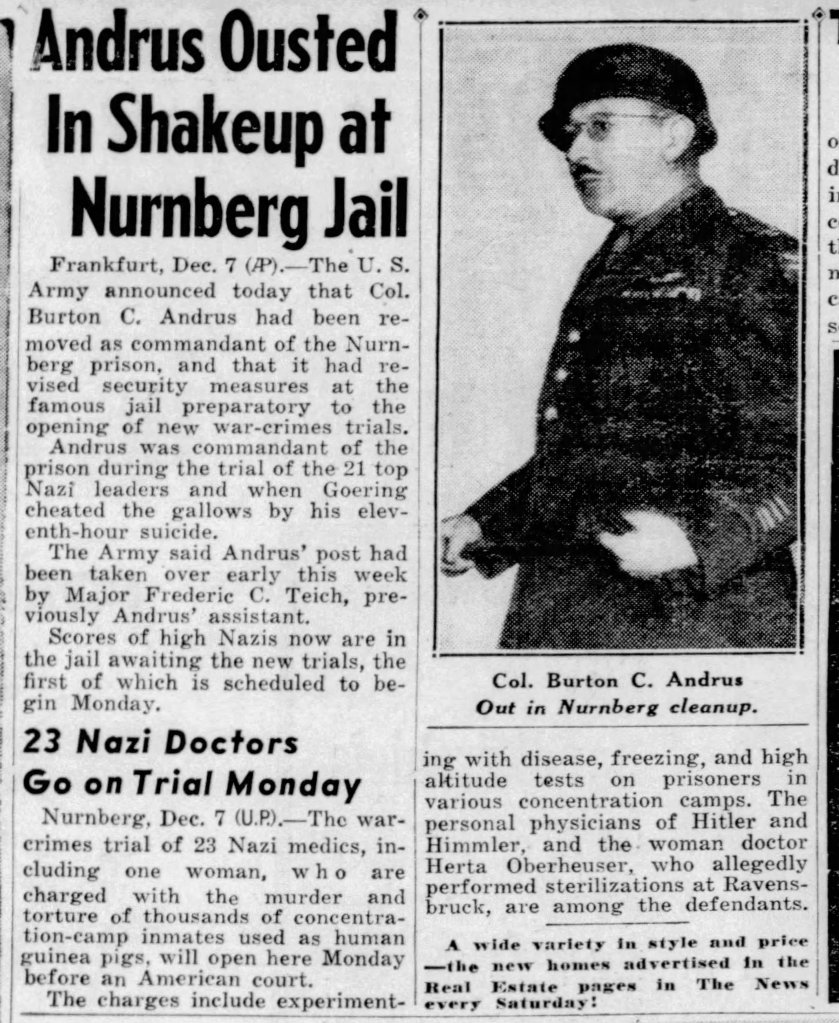

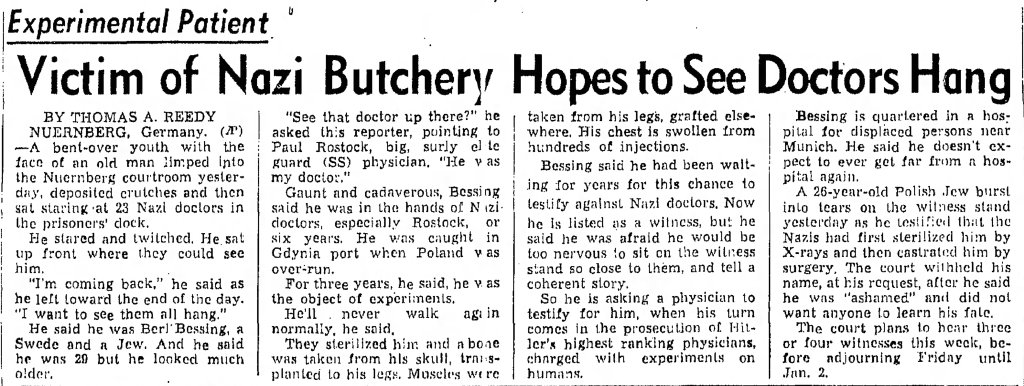
There were many, many more headlines around the country regarding the beginning of the trial. Just as intriguing was looking at the other headlines from the same page of the papers.
DON’T HANG HIM, WE NEED HIM
Dr. Theodor Benzinger, one of the named defendants in the doctors’ trial, was suddenly released from prison and back into US custody before the trials even began. It was later uncovered that he had completed a study on “pilot physiology concerning stratospheric aircraft.” He also studied water desalinization [to increase survival rates of pilots shot down at sea] and is believed to have participated in some of the freezing experiments.
The Army Air Forces at Wright Field were very interested in this research. They determined it was in the national interest” to retain him rather than try him for war crimes.
Dr. Benzinger and 34 other doctors from Heidelberg were shipped over to the United States in February, 1947.
Many more would soon follow.
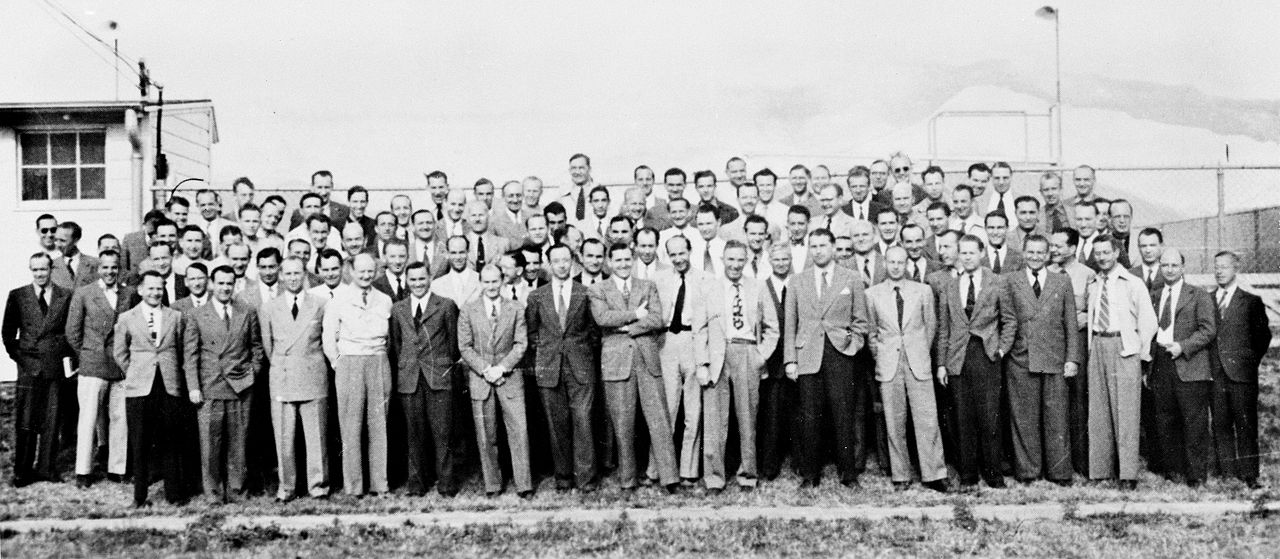







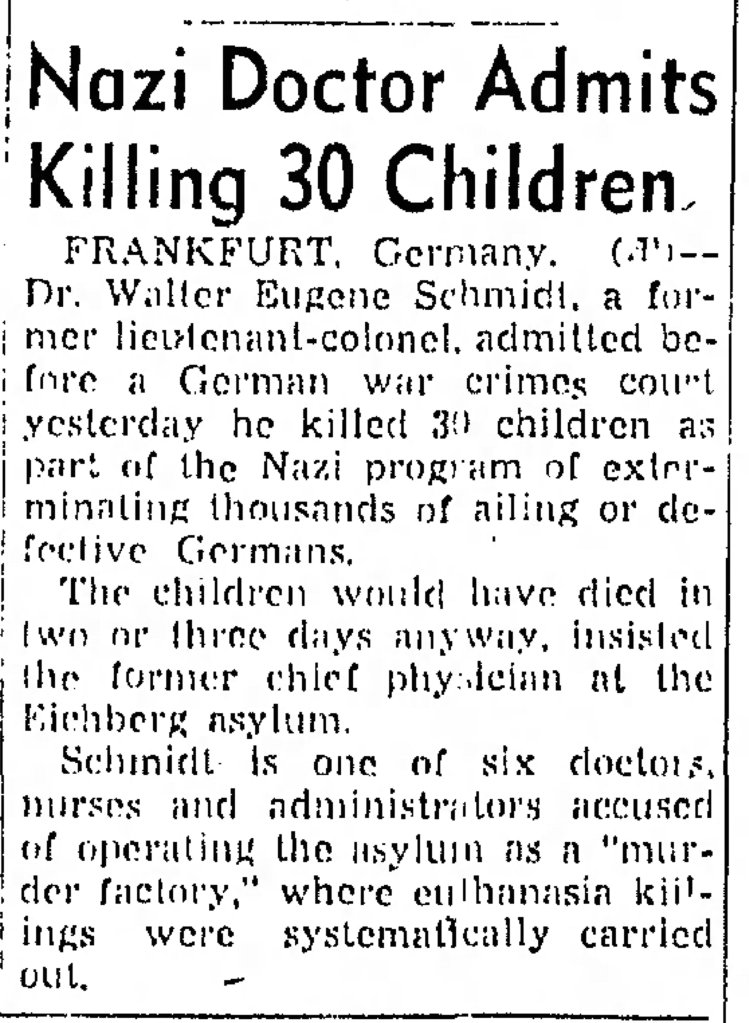




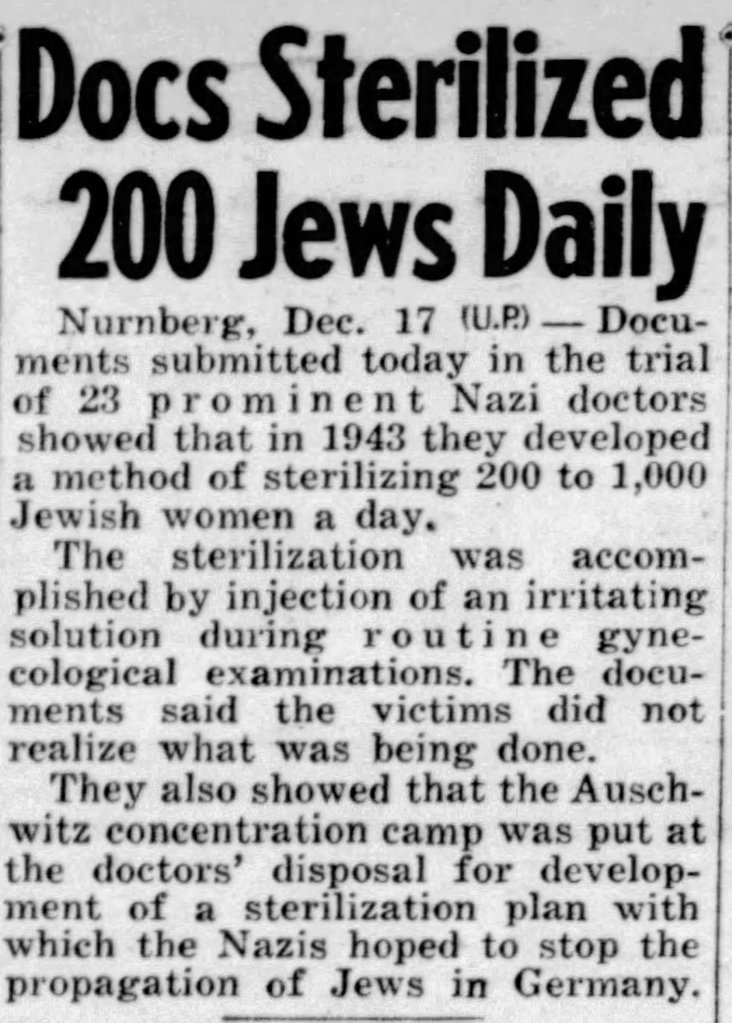
3 Comments